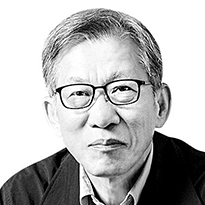Buttressing the K-wave by sharing Korean art with the world

Yoo Hong-jun
The author, a columnist of the JoongAng Ilbo, is a chair professor on art history at Myongji University and former director of the Cultural Heritage Administration.
The K-wave remains at high tide. The hype may be felt at home, but anyone who has been overseas commonly raves in excitement and pride upon discovering the overwhelmingly heightened regard for Korea.
The K-wave has become almost synonymous with K-pop. Idol groups like BTS and Blackpink hitting Billboard and other global musical charts no longer makes headline news. Other idol stars, dancers and fusion groups mixing pop and traditional Korean folk tunes roaming around the world, and the flood of cover and random play dance scenes by Europeans and Latin Americans in city plazas dominating YouTube, are mind-blowing. The K-wave that originated with TV dramas has built up with pop music, food and lifestyle to spill over to high-end culture like literature and arts. The translated versions of “The Vegetarian” by Han Kang, “Please Look After Mom” by Shin Kyoung-Sook and “Kim Ji-yhoung, Born 1982” by Cho Nam-joo have transcended language and cultural barriers to add literature to the K-list.
The arts also have made strides. New York City’s Rockefeller Center celebrated Korean artists for the first time in this year’s summer festival. The “Origin, Emergency, Return” exhibit showcased more than 70 works of Park Seo-bo, famous for his “Ecriture” monochrome painting series, Korean-American artist Jin Meyerson and Germany-based painter Yoon Jongsuk. Lee Bae’s 21-foot tower of stacked charcoal stood tall in front of Rockefeller Center’s Channel Gardens, the first Korean artist's occupation of the space, during the festival.
![Lee Bae’s “Issu du feu” stands 21 feet tall at the Channel Gardens, Rockefeller Center, New York City. [FITZ & Co]](https://koreajoongangdaily.joins.com/data/photo/2023/08/04/4d3e2321-a188-49bb-bd11-586d3cda903f.jpg)
Lee Bae’s “Issu du feu” stands 21 feet tall at the Channel Gardens, Rockefeller Center, New York City. [FITZ & Co]
The "Only the Young: Experimental Art in Korea, 1960s–1970s" exhibit, jointly held by the National Museum of Contemporary Art, Korea (MMCA) and Solomon R. Guggenheim Museum with work by Kim Ku-lim, Lee Kang-so, Lee Kun-yong and Lee Seung-taek, ended its Seoul show and is scheduled to go display in Guggenheim Museum in New York from September to January and the Hammer Museum in Los Angeles from February to May.
The Philadelphia Museum of Art will exhibit Korean modern art for the first time in its 150-year history with the "The Shape of Time: Korean Art after 1989" exhibit next October, featuring artwork by 33 artists like Suh Do-ho, Ham Kyung-ah and Shin Mee-kyoung.
After a successful debut last year, global art fair Frieze is returning to COEX in Seoul in September for a joint art fair with Kiaf Seoul, Korea’s longest-running art fair hosted by the Galleries Association of Korea, with 200 galleries from 30 countries joining the extravaganza.
The K-wave is exciting not just interest in Korean culture but awe and envy. I learned during my visit to Paris for a lecture last summer from headmasters of Korean language schools that Korean has surpassed Chinese and Japanese as a second foreign language in France. The King Sejong Institute, which runs Korean language institutes in 2,400 countries, holds the World Korean Educator Conference in Seoul this month.
The K-culture wave is ushering visitors to the Korean sections of famous museums. But people who have visited the Korean rooms at the British Museum in London, Metropolitan Museum of Art in New York and Guimet Museum in Paris leave in disappointment as the artworks and exhibits are pitifully small-scaled and scant compared with the Chinese and Japanese sections.
The Victoria & Albert (V&A) Museum of London, the world’s biggest craftwork museum, in October last year held the “Hallyu! The Korean Wave” exhibit. A friend residing in the U.K. who saw the exhibit said Korea needs to showcase an exhibition showing the roots of Hallyu, not one to flaunt the fandom of Korean pop culture today.
Michael Cunningham, former curator at the Asian Art Department Records of the Cleveland Museum of Art, admitted that Asian arts majors in western societies learned of the splendid tradition of Korean art history only after seeing the “5,000 Years of Korean Arts” exhibit that toured seven U.S. cities for three years from 1979. His confession confirms that art play a concrete role as a "diplomat of material culture," sharing the culture and history of the nation.
We must arrange a new tour of “5,000 years of Korean Arts” to major cities like Paris, London, and New York to parade the long cultural tradition behind K-culture so that Hallyu can continue to flow expansively and extensively.
Translation by the Korea JoongAng Daily staff










with the Korea JoongAng Daily
To write comments, please log in to one of the accounts.
Standards Board Policy (0/250자)